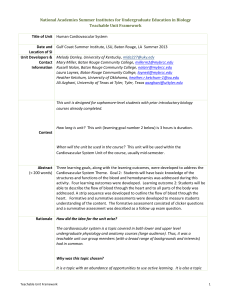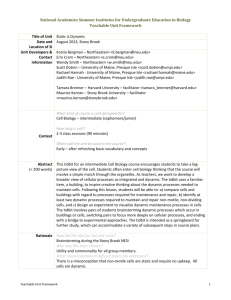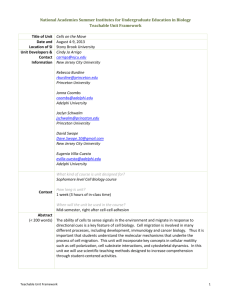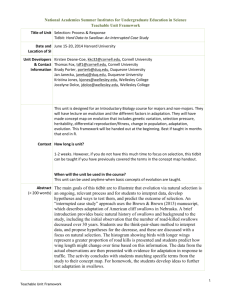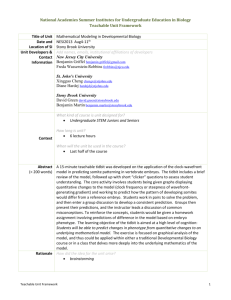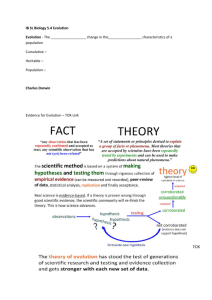Germs, Drugs, and Genes (framework) West Coast 2013
advertisement
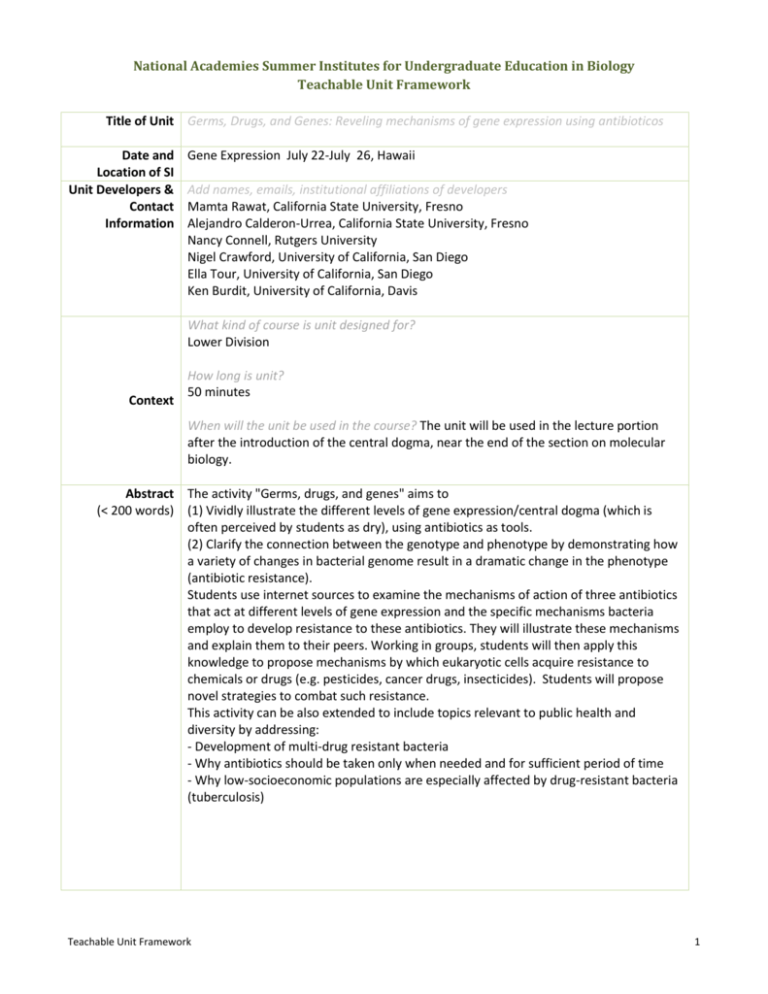
National Academies Summer Institutes for Undergraduate Education in Biology Teachable Unit Framework Title of Unit Germs, Drugs, and Genes: Reveling mechanisms of gene expression using antibioticos Date and Location of SI Unit Developers & Contact Information Gene Expression July 22-July 26, Hawaii Add names, emails, institutional affiliations of developers Mamta Rawat, California State University, Fresno Alejandro Calderon-Urrea, California State University, Fresno Nancy Connell, Rutgers University Nigel Crawford, University of California, San Diego Ella Tour, University of California, San Diego Ken Burdit, University of California, Davis What kind of course is unit designed for? Lower Division Context How long is unit? 50 minutes When will the unit be used in the course? The unit will be used in the lecture portion after the introduction of the central dogma, near the end of the section on molecular biology. Abstract The activity "Germs, drugs, and genes" aims to (< 200 words) (1) Vividly illustrate the different levels of gene expression/central dogma (which is often perceived by students as dry), using antibiotics as tools. (2) Clarify the connection between the genotype and phenotype by demonstrating how a variety of changes in bacterial genome result in a dramatic change in the phenotype (antibiotic resistance). Students use internet sources to examine the mechanisms of action of three antibiotics that act at different levels of gene expression and the specific mechanisms bacteria employ to develop resistance to these antibiotics. They will illustrate these mechanisms and explain them to their peers. Working in groups, students will then apply this knowledge to propose mechanisms by which eukaryotic cells acquire resistance to chemicals or drugs (e.g. pesticides, cancer drugs, insecticides). Students will propose novel strategies to combat such resistance. This activity can be also extended to include topics relevant to public health and diversity by addressing: - Development of multi-drug resistant bacteria - Why antibiotics should be taken only when needed and for sufficient period of time - Why low-socioeconomic populations are especially affected by drug-resistant bacteria (tuberculosis) Teachable Unit Framework 1 National Academies Summer Institutes for Undergraduate Education in Biology Teachable Unit Framework Rationale How did the idea for the unit arise? “How genotype relates to phenotype” is one of the fundamental concepts in molecular biology. We wanted to emphasize this concept and ensure that the students understood it thoroughly. Why was this topic chosen? Antibiotic resistance has significant societal implications and thus it is a topic that students can relate to. What misconceptions or difficult topics are addressed?. We address the misconception that (1) humans become resistant to antibiotics, (2) bacteria develop resistance as a result of exposure to antibiotics as opposed to natural selection of a variant in the population, and (3) resistance is induced in bacteria by the antibiotic. How resistance arises in bacteria and chemical resistance occurs in eukaryotes are difficult topics that are addressed in the tidbit. Learning Goals: what students will know, understand, and be able to do; includes content knowledge, attitudes, & skills Learning Outcomes: Student behaviors or performances that will indicate they have successfully accomplished the goals 1. The student will be able to understand how genotype determines phenotype. 2. The student will identify steps in gene expression and how some drugs affect different levels of gene expression. 1. The student will find and illustrate the mechanisms of action of certain antibiotics and relate these actions of antibiotics to steps in gene expression. 2. The student will be able to explain how resistance to antibiotics arises from a change in the genetic material of the cell. 3. The student will be able to apply principles of antibiotic resistance in bacteria to drug resistance in eukaryotic cells. 4. The student will propose strategies for the development of new drugs. Incorporation of Scientific Teaching Themes Active Learning How students will engage actively in learning the concepts Teachable Unit Framework Assessment How teachers will measure learning; how students will selfevaluate learning Diversity How the unit is designed to include participants with a variety of experiences, abilities, and characteristics 2 National Academies Summer Institutes for Undergraduate Education in Biology Teachable Unit Framework Activities outside of class: Homework-Cancer cells and resistance Pre-assessments: Pre/Post test (uploaded document) Activities in class: A1: Pre-test A2: Group share 1 Assign an antibiotic to pairs of students in each group. The members search the internet to find out about the targets of the antibiotics and report to group. Post-tidbit assessments: Pre/Post test Homework on cancer cells and resistance Questions on final exam Lecture, clicker question, internet search and group work are included. Exercises that include listening, writing, and drawing are used to address different learning styles. Supplemental activities involving multi-drug/extremely drug resistant tuberculosis or malaria are mentioned to increase extend the socio-economic diversity of the teaching unit. The group draws a bacterial cell on poster paper and each pair illustrates the targets of antibiotics. The groups report out to class and responses are compared to professor’s diagram. A3: Clicker question on alternative “conceptions” of antibiotic resistance Peer instruction: Vote, Think pair share, Re-vote, followed by discussion of different options by instructor A4: Class discussion How could a mutation lead to antibiotic resistance? Propose mechanisms or targets in bacteria that could be altered to produce resistance. A5: Internet search Use the internet to find mechanisms of resistance for your antibiotic. Report to group. Use your drawings to illustrate what you found. A6: Group share Teachable Unit Framework 3 National Academies Summer Institutes for Undergraduate Education in Biology Teachable Unit Framework Can you think of an instance in which eukaryotic cells acquire resistance to drugs or chemicals? Report . A7: Post-test Sample Presentation Plan (general schedule with approximate timing for unit) Session 1 Time (min) Learning Outcome(s) Activity/assessment Explanation, notes, suggestions, tips Preclass Enter approx. class time for learning activity preparatory material presentation Enter approx. class time for Teachable Unit Framework 4 National Academies Summer Institutes for Undergraduate Education in Biology Teachable Unit Framework learning activity #1 Enter approximate time for additional learning activities and associated class Work/preparatory materials Enter approximate time for post-activity summing up or transition Add additional activities information as needed for the unit. Resources for Teaching the Unit (other files and information needed/helpful to teach the unit, including files for papers from which original data for class activities is taken, supporting information for the instructor, handouts, in class activities materials, assessments with answer keys, homework assignments, etc.) Pre/post test Powerpoint presentation Microbe publication entitled “Moving targets: Fighting resistance in infections, cancers, pests” (July 2013) Effectiveness of unit (if you have used it in your own teaching) Teachable Unit Framework 5 National Academies Summer Institutes for Undergraduate Education in Biology Teachable Unit Framework Acknowledgements (Facilitators, others who gave input, information, etc.) Teachable Unit Framework 6




